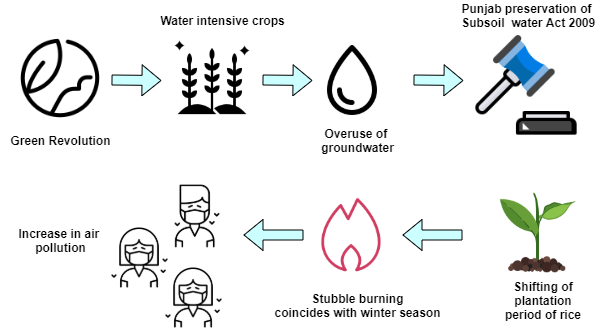Introduction
In winters, every year air pollution level in the Delhi reaches to an alarming level, turning it into a ‘gas chamber’. Burning of crop residues i.e., stubble burning in states of Punjab & Haryana, has been cited as a main reason behind it.
Whereas the main reason behind stubble burning is the Preservation of Subsoil Water Acts passed by Punjab & Haryana in 2009. However, root of this whole menace lies in the green revolution. So, let’s understand how green revolution has increased the problem of air pollution in India.
Changes Introduced by Green Revolution
Green Revolution of 1960s and 1970s made India self-sufficient in food grain production. Government provided several policy incentives to farmers, like:
- Price support for crops
- High-yielding seeds
- Expanded irrigation:
- Increased use of fertilizers, pesticides and weedicides in order to reduce agricultural loses
- Introduction of combine harvesters
However, these changes were accompanied by a huge ecological cost.
Negative impacts of green revolution
- Establishment of a rice-wheat monoculture: Due to policy incentives from government, farmers were able to sow high-yielding & water-intensive crops, like rice & wheat. (To produce a kg of rice 2,800 ltrs of water is required, while a kilogram of wheat takes 1,654 ltrs on average.) This established a Rice-Wheat-Cropping-System (RWCS) in these areas, which was not suitable.
- Rapid Depletion of groundwater resources: Fields now remained under cultivation for almost 10 months a year causing an over-exploitation of groundwater.
- Crop Residue: Usage of combine harvesters left a sharper and taller crop residue in the fields post-harvest. This straw was potentially injurious to farmers, unsuitable as an animal fodder and got stuck in the machines used for planting the next crop. Further, this type of straw was difficult to remove manually. Hence, burning afforded the quickest alternative. This led to an increase in stubble (crop residue) burning cases.
Thus, Green revolution had few unintended consequences in northern India, like increased exploitation of groundwater (water intensive crops), air pollution (increased stubble burning) and establishment of a monoculture
To arrest this drastic fall in groundwater, Punjab & Haryana government passed Punjab Preservation of Subsoil Water (PPSW) Act and the Haryana Preservation of Subsoil Water (HPSW) Act respectively in 2009.
What are the Preservation of Subsoil Water Act passed by Haryana & Punjab in 2009?
Acts mandated delaying the transplanting of paddy beyond June 10, when the most severe phase of evapotranspiration (transfer of water from land to the atmosphere through evaporation from the soil and plant transpiration) is over.
- As per PPSW – Farmers were forbidden from sowing paddy before 10th May, and transplanting it before 10th June.
- As per HPSW – Farmers were forbidden to sow paddy before 15th May and transplanting it before 15th June.
Situation before Acts were passed
Before the acts, nursery-raising happened in April last week and transplanting by mid-May, to enable harvesting from October and timely planting of the next wheat crop. But being peak summer time, it resulted in a very high-water requirement.
Negative impact of the Acts
- Shifting of rice plantation schedule: Acts pushed the plantation schedule from May to June. This was done to bring cultivation closer to monsoon period. This caused the following:
- Shortened window b/w harvest of paddy & sowing of wheat: As now rice was planted later so farmers now got fewer number of days b/w harvesting paddy and planting the next crop, mainly wheat. This resulted in farmers being forced to burn their residues (stubble) as a quick fix solution.
- Stubble burning coincides with onset of winter: This further meant that time period of stubble burning coincided with the onset of winter in Northern India. This magnified the problem of air pollution over the northern region especially in Delhi.
Why stubble burning during winter season causes increase in air pollution in Delhi?
During onset of winter season in northern India, two things happen:
- Slower wind movement
- Higher moisture level in lower atmosphere
- Both these factors result in the formation of a layer, due to which all the particulate matter and gases from the burnt stubble, as well as vehicles and industries, get accumulated, instead of moving away.
- Direction of winds: During this time of the year, slower winds in Punjab generally blow from the northwest to the southeast, discouraging dispersion of pollution.
Thus, to summarize, this is what happened.
- Green Revolution led to an over-exploitation of groundwater.
- To tackle this problem, PPSW & HPSW acts were passed which exacerbated the problem of air pollution

Five possible solutions
- Promote rice varieties that either take less time to grow or are less water-intensive
- Support by state government: State government should provide better subsidy so that farmer can afford crop residue management machinery
- Innovative uses for crop residue: Instead of burning stubble, it can be used in different ways like cattle feed, compost manure, roofing in rural areas, biomass energy etc.
- Dhaincha (Sesbania aculeata): Dhaincha is a green manure plant sown on an uncleared field. When the plant matures in two-three months, it is ploughed over, and mixed in the soil. The process takes care of the last crop’s residue (which has decayed by now), and also adds nitrogen to the soil
- Establishment of bio-refineries for utilisation of paddy straw in biomass-based power projects is another viable option.





